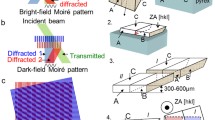Abstract
The three fundamental optical phenomena of diffraction, two-beam interference, and transformation by a lens form the basis of modern moiré strain-measurement techniques. The improved understanding of diffraction by superimposed gratings and optical spatial filtering leads to a general gain of freedom in designing moiré experiments. Benefits characteristic of refined but very simple optical-data-processing techniques include simpler apparatus, less-demanding procedure, possible large gains in sensitivity, and the ability to choose certain moiré parameters, such as sensitivity,after an experiment is concluded and the raw data stored. Sample results from a study of strains near cold-worked holes demonstrate that acceptable results can be had with elementary apparatus and systematic exploitation of optical-data processing.
Similar content being viewed by others
References
Guild, J., The Interference Systems of Crossed Diffraction Gratings, Clarendon Press Oxford (1956).
Post, D., “Analysis of Moiré Fringe Multiplication Phenomena,”App. Opt.,6 (11),1938 (Nov.1967).
Post, D., “New Optical Methods of Moiré-fringe Multiplication,”Experimental Mechanics,8 (2),63–68 (Feb.1968).
Post, D., “Moiré Fringe Multiplication with a Nonsymmetrical Doubly Blazed Reference Grating,”App. Opt.,10 (4)901 (April1971).
Post, D. andMcLaughlin, T.F., “Strain Analysis by Moiré-fringe Multiplication,”Experimental Mechanics,11 (9),408–413 (Sept.1971).
Holister, G.S., “Moiré Method of Surface Strain Measurement,”The Engineer,223,5792,149 (January,1967).
Cloud, G.L., “Lasers In Engineering Education,”Eng. Ed.,66 (8),837 (May1976).
Vander Lugt, A., “A Review of Optical Data-Processing Techniques,”Optica Acta,15 (1),1–333 (Jan.1968).
Clark, J.A., Durelli, A.J. andParks, V.J., “Shear and Rotation Moiré Patterns Obtained by Spatial Filtering of Diffraction Patterns,”J. Strain Anal.,6 (2),134 (1971).
Nagae, S., Iwata, K. andNagata, R., “Measurement of Strain Distribution in a Plane Metal Plate by Optical Spatial Filtering,”App. Opt.,14 (1),115 (Jan.1975).
Chiang, F.P., “Techniques of Optical Spatial Filtering Applied to Processing of Moiré-Fringe Patterns,”Experimental Mechanics,9 (11),523–526 (Nov1969).
Cloud, G.L., Residual Surface Strain in Distributions Near Holes which Are Coldworked to Various Degrees, Air-Force Materials Laboratory, Technical Report AFML-TR-78-153),Wright-Patterson Air Force Base, OH (1978).
Cloud, G.L., “Measurement of Strain Near Coldworked Holes,”Experimental Mechanics,20 (1),9–16 (Jan.1980).
Cloud, G.L., “Slotted Apertures for Multiplying Grating Frequencies and Sharpening Fringe Patterns in Moiré Photography,”Optical Eng.,15 (6),578–582 (Nov.–Dec.1976).
Author information
Authors and Affiliations
Rights and permissions
About this article
Cite this article
Cloud, G.L. Simple optical processing of moiré-grating photographs. Experimental Mechanics 20, 265–272 (1980). https://doi.org/10.1007/BF02328410
Received:
Revised:
Issue Date:
DOI: https://doi.org/10.1007/BF02328410



